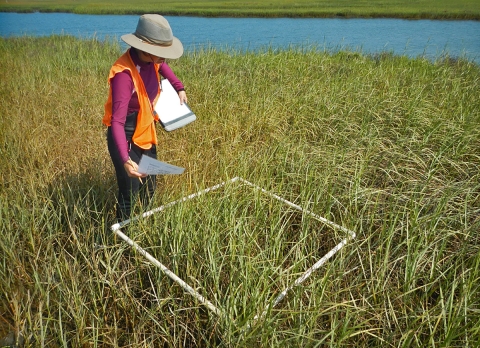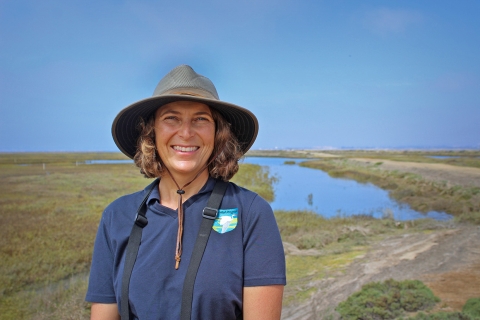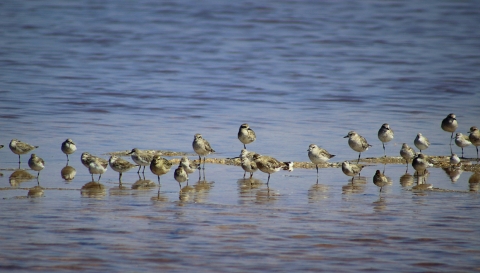Two unique landscapes share a space within one unit of the San Diego Bay National Wildlife Refuge in San Diego, California — a working saltworks industrial site, San Diego’s oldest business, and hundreds of acres of lush green habitat.
The 2,300-acre South San Diego Bay Unit was established in the mid-1990s to shelter, protect and restore habitat for hundreds of thousands of birds migrating along the Pacific Flyway, as well as for the bay’s resident species.
“This piece of land wasn’t always like this,” said Carolyn Lieberman, U.S. Fish and Wildlife Service Coastal Program coordinator for the Carlsbad office. “All the green you see now, imagine no plants – just patches of water and mud everywhere.”
The now flourishing habitat, known as the western salt pond restoration project, is the outcome of a partnership initiated in 2008 by the U.S. Fish and Wildlife Service’s Coastal Program and National Wildlife Refuge System, along with the California State Coastal Conservancy and Port of San Diego. The partnership expanded to include 12 partners providing funding or in-kind contributions to the project. This collaboration collectively restored 300 acres of habitat at the refuge’s western salt ponds, and the Port of San Diego’s Chula Vista Wildlife Reserve and Emory Cove.
“This was my first project starting as Coastal Program lead,” said Lieberman, who has been with the U.S. Fish and Wildlife Service for 18 years. “I chose to work on it because I was already familiar with the restoration plan and had developed a good working relationship with the landowners and project partners from my previous position.”
Completed within two years (March 2010 to December 2011), the restoration itself was relatively fast. As with any big project, there were some unexpected challenges.
“We expected that the material we were importing from the Chula Vista Wildlife Reserve to create additional marsh habitat would be silts and clays - appropriate for marsh soils,” said Lieberman. “Instead, we received beautiful white sand. As such, we changed our project design to include an area of sand for nesting and roosting migratory birds.”
And what’s most exciting is that endangered bird species use the site.
“I was ecstatic that the vegetation we seeded took well,” said Lieberman. “Last fall, I witnessed an endangered Ridgway’s rail actually hunker down in a stand of pickleweed. I’ve also observed western sandpipers, willets, black bellied plover, California horned snail, fish and more using the site.”
“We – and the locals who surround this refuge – have seen so much come back over the years,” said Lisa Cox, public information officer at San Diego National Wildlife Refuge Complex. “Now people can walk along the new Bayside Birding and Walking Trail and watch hundreds of birds foraging in the marsh in the morning and listen to light-footed Ridgway’s rails at dusk.”
A five-year post construction monitoring survey was recently conducted and documented 80 species of birds, 22 species of fish and 10 species of invertebrates using the site.
“This was by far one of the most satisfying projects of my career, and I really enjoyed working with all the people involved,” said Lieberman. “We restored so much habitat and now the ecosystem there is booming.”
Project partners included the Port of San Diego, California State Coastal Conservancy, National Oceanic and Atmospheric Administration Restoration Center, Environmental Protection Agency, U.S. Fish and Wildlife Service Coastal Program, Wildlife and Sport Fish Restoration Program and National Wildlife Refuge System, Southwest Wetlands Interpretive Association, San Diego Oceans Foundation, Ocean Discovery Institute, San Diego Audubon Society and Coronado Cays Homeowners Association.









